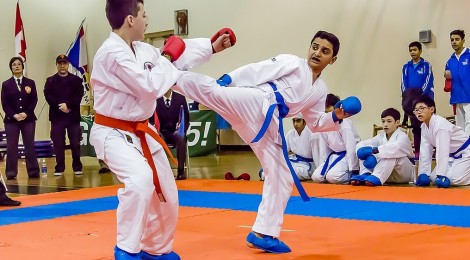
7 Reasons Why Karate is Better for your Kids than Team Sports
7 Reasons Why Karate is Better for your Kids than Team Sports
Below are a few reasons to consider Karate (or another Martial Art) for your Child or Adolescent over the traditional team sports Team Sports:
Self-Defense
This is the number one reason why most people decide to study martial arts, and pretty much any style is a great way to learn how to defend yourself. Martial arts teach you the techniques to defend yourself, but also the way to think about defending yourself – anticipate and avoid potential dangers. Training also helps build up the reflexes you need if you’re ever in a dangerous situation, and give you the confidence to stand up for yourself and fight back if needed – which brings us to our next topic…
Self-Confidence
As children become more proficient in their selected style of martial arts, their confidence gets a big-boost. They become more self-assured and confident. Their Sensei’s encouragement goes a long way to help them achieve this goal, but the confidence level will extend far beyond the dojo.
Belts and Ranking
Belts and rankings are a public recognition among peers for the student’s effort and progress. Martial Arts ranking system helps teach children to set goals and achieve them, to persevere and prioritize.
Discipline
Martial Arts training is a physical expression of ‘practice makes perfect’. In a class a student may execute a single movement or series of related movements, hundreds of times. This teaches the student that the progress that always happens during small improvements in technique and stamina, flexibility or power – will come through endless repetition.
Even during kumite (sparring) – where the student shows how creatively he or she can apply their well-honed skills – there are still rules and protocols to be followed. All of this teaches children to respect one another, their opponents and colleagues, and how to play games fair and square – lessons that follow them in their non-Martial Arts lives. It also teaches them to commit, to go to practice even when they don’t feel like it.
Individual Achievement: No one sits on the Bench
Many kids have the chance to experience the benefits of Martial Arts early on, however a big number of children abandon their martial arts training when reaching the teen years in order to participate in school sports.
Although there are many lessons to be learned from team and individual varsity sports, the ‘make the team’ model often favors the more physically developed players while alienating the late bloomers.
Coaches have access to an endless supply of players that renews itself each year, the big and strong get picked and get to play while the less physically developed watch from the bench, this leads to a even greater disparity in skill development as the season goes by.
Gender Equality
I am sure that while many parents would consider martial arts for their sons, not nearly as many would consider it for their daughters. However the martial arts are one of the few sports where both boys and girls can play together.
Martial Artist also gives brothers and sisters an opportunity to practice together and learn from one another as well (not to mention the convenience of having all of your kids in one place at a time).
Weight Control
Childhood obesity is a global epidemic and rising trends in overweight and obesity are apparent in both developed and developing countries (CDC stats).
The typical martial arts class will often be comprised of warm-up calisthenics, teaching and practicing of moves and possibly some sparring, as well as some active games. The warm up and practice comprise the bulk of the time, and for that time your child will be constantly on the go – stretching, crunches, takedowns, grappling, punches and kicks. The workout each child gets will not only assist in the natural development of his or her muscles, but also help them build stronger Cardio-Vascular systems. Even in the most active of team sports such as Basketball or Soccer, children don’t get that much of a workout simply because they generally don’t play the whole game and even if they do, there are still breaks in the action.
Independence
Although practicing karate is primarily an individual sport, it is still in many ways seen as a team sport. Each training session, students work either with a partner or a small group. A certain level of trust and respect is needed in order for this training to flourish since there will be punches and kicks being thrown at each other! In most established karate schools, the dojo is like a family – peers are seen as brothers or sisters; and because of the never ending karate season, these same peers will grow up with each other together as they progress through the ranks. Many friendships forged through training together over the years last a life time.
However, with all of this being said, at the end of the day it is up to each student to assume responsibility for their own actions when they enter a competition. Sure a coach can give advice from the side of the ring, and friends can cheer from the sidelines, but it’s up to the athlete who is in the ring to take care of business by themselves. This experience is one of the most rewarding I have had, and I am very thankful for the opportunity. These karate lessons translate to life lessons that will always be with us.
